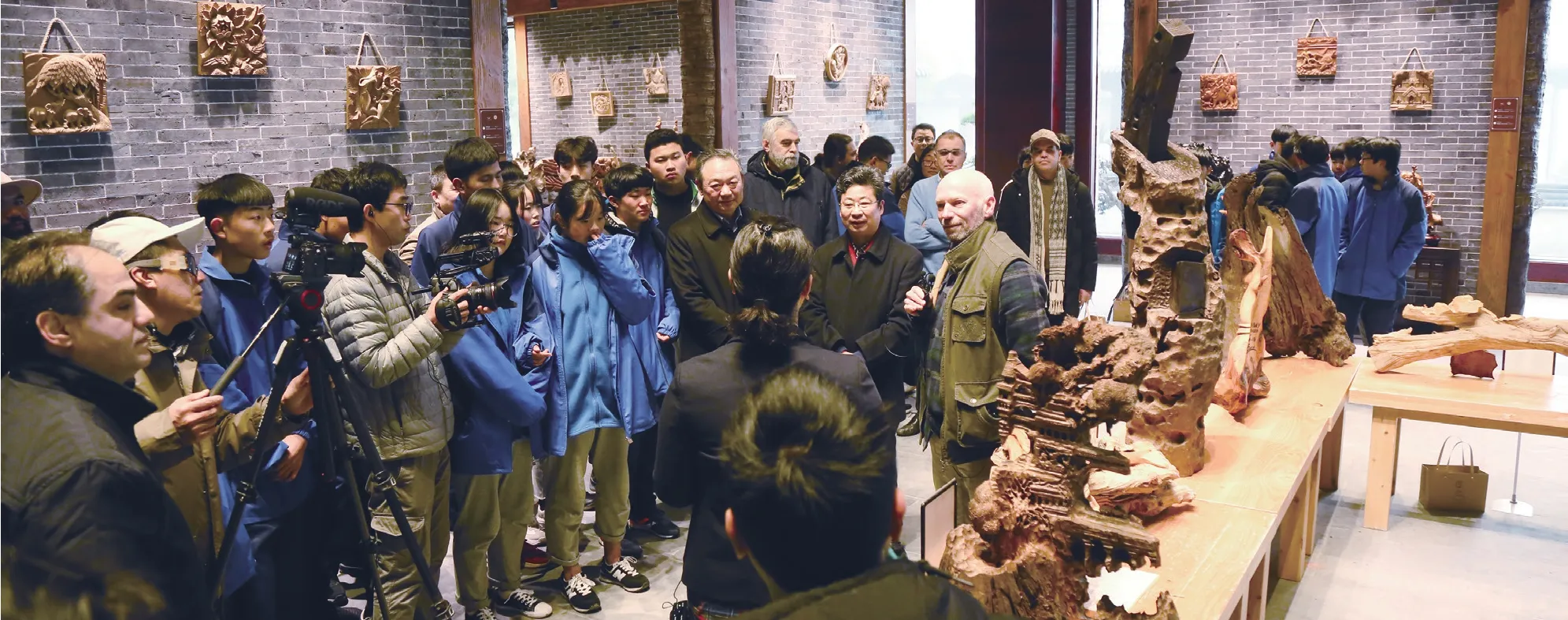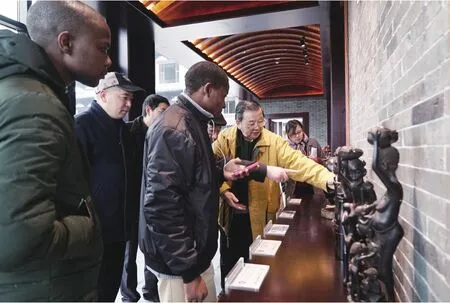以根问道
文/ 赖 子

2020年12月,衢州市开化县根宫佛国文化旅游区荣获“全球最大的根雕博物馆”吉尼斯世界纪录称号。In December 2020, Root Palace Buddha Country Culture Tourism Area broke the Guinness World Records and became the largest root carving museum in the world.
循着“嘎吱”的锯与木的摩擦声,以及“啪啪”有节奏的凿撞击根的声音,来到根宫佛国三期的“醉根杯”中国根雕现场创作大赛基地。在三百米的长廊里摆放了五十多张的创作台,不少根雕艺人正紧张地雕刻着,靠墙角的那位入定似的,盯着一截根桩,另一位手舞足蹈,与根共舞……这已是第六届“醉根杯”大赛,来自北京、浙江、福建、河南、河北、湖南等十余个省份的四十多位代表国内一流根艺水平的艺术家参加。其间,常见一位胡须拉碴、精神矍铄的中年人缓步于此,只是看看笑笑,他便是大赛的组织者徐谷青。
开化追梦 文化寻根
位于钱塘江上游的小城开化,宁静而葱郁,地处浙、皖、赣三省七县交界地,是全国著名的“中国根雕艺术之乡”。“开化根雕”起源于唐武德四年,从明末开始根雕才从木雕中渐渐分离开来,成单独的艺术门类。《雍正开化县志》记载:“城中近百所来所有之坊为十二,皆有坊门望楼。”从政义坊望楼残留的木结构可以看出,开化的木雕已达到较高的艺术水准。清光绪《开化县志》载:“宋国光,字尔衍,清乾隆邑痒生,授例就营千总,善绘画,善雕琢,得盘根错节之树桩,随手刻划为人物花鸟,见者叹以为真。钟峰书院落成,门窗雕刻竹叶,镂梅花兼绘古十八学士栏壁,形神毕肖。”一代根雕宗师宋国光授艺于徐元祥,其后形成徐氏根雕派。发展根雕艺术,传播根雕文化,打响根雕品牌,做大根雕产业,一直是开化人的梦想。
而真正将根雕做大的是后辈徐谷青。他1966年8月15日出生在衢州开化县林山乡梅岭村,这是一个被称为悬崖上的村庄,众山夹峙的深山凹,交通闭塞,土地贫瘠。或许正是这样的环境,造就他敢闯敢拼、做事就要做到极致的韧劲。初中毕业后被迫辍学,但稍有闲暇,他就用心钻研木雕、壁画和书法。如今在他的工作室内,悬挂着一幅大型的根书—一个“闯”字,这是他对根艺事业的信心和动力的写照。原中国根艺美术学会副主席李蒂、上海根艺美术学会会长胡仁甫给了他许多教益。原中国美术学院院长肖峰称他为“根疯”,胡仁甫因他醉心于根艺,给了一个艺号“醉根”。
1991年,回到家乡的徐谷青组建开化根雕厂并注册“醉根”商标,带徒授艺,开化根雕庞大的队伍里,半数以上曾在徐谷青的根雕厂学习或工作,接受过他的言传身教。开化不仅具有浓厚的根雕艺术氛围,而且其艺术自成风格,选材奇绝、创作精巧、品种丰富,人物作品、自然造型、动物飞禽、四季果蔬以及实用居家用品一应俱全。特别是徐谷青的巨型根艺作品,造型简洁古朴、气韵生动、气势磅礴,创作了世界罕见的巨型根雕群《五百罗汉》《观音百态》等根雕艺术群,以根代言,一把刻刀,让内心对生活乃至生命的感悟栩栩涌现。巨型根艺《五百罗汉》是徐谷青和他的团队利用千年以上的大型龙眼木根桩,精雕慢琢、巧夺天工而成的。他们施以局部刀笔,形象栩栩如生,各尊罗汉特点捕捉到位,充分利用材料的形态、色泽、质感以及根桩的天然肌理,人物形神兼备、衣纹流畅、富有不同的质感,使作品在艺术与自然两方面达到和谐和统一。
从“手雕”走向“心雕”
开化根雕在传承“海派”根雕基础上又有新的突破,更强调无为而“制”,人补天不足,从“雕”走向“不雕”,从“手雕”走向“心雕”,有时纯用“心雕”法取胜。努力将“巧夺天工”与“巧用天工”结合得更加完美,“三分人工,七分自然”,这是一般见工不见艺的根艺之作所无法比拟的。有些作品非常接近当代观念艺术,与现代装置艺术与抽象艺术是近邻。徐谷青赋予奇巧的根材以生命的动感和情韵,努力打破传统根雕艺术限于在室内摆置的框框而走向户外,以期取得如同城市雕塑的功能,创造真正的现代根艺。如《世纪门》作品取自一个整块的树根,天生自然。里面是自然腐烂掉形成的沟壑,外面是树的筋骨。徐谷青顺其根材原有的造型态势,从长势、筋骨出发把最为自然的大地语言同他的艺术语言融合起来。经过多年积累,开化根雕逐步形成了融根艺、佛学、美学、生态学于一体,具有独特地方艺术魅力的根雕文化,被列为浙江省非物质文化遗产,是继东阳木雕、青田石雕、黄杨木雕之后浙江第四雕,是九大历史经典产业之一。
2020年,针对根雕业内制作工艺传统滞后、技艺传承与创新力度不够、整体上艺术水平不高的现状,他牵头制定浙江制造品牌标准《开化传统艺术根雕》,这是根雕产业向规范发展的首创之举,以“品字标”浙江制造和“国内一流、国际先进”高标准定位,制定了包含根雕产品分类、设计要求、选材要求、工艺要求、检测要求、产品质量要求以及试验方法、标志、包装、运输、贮存、质量承诺、根雕设计制作交易等全过程的标准,这也是中国第一个传统经典技艺的标牌。

根雕作品《五百罗汉》。The 500 Arhats, a root carving artwork.
在徐谷青带动下,开化根艺企业发展迅猛,他一手创办的衢州醉根艺品有限公司已发展成为国内最大的根雕企业,公司投资建设的根宫佛国文化旅游区,不仅是世界唯一的大型根文化主题公园、国家AAAAA级景区,是目前国内规模最大、工艺水平最高、以根雕为主题的国家文化产业示范基地,更是传统工艺与文化旅游结合的成功典范。如今,开化的根艺企业有28家,从业人员达2200余人,每年加工创作根雕作品超过30万件(套)以上,形成了开化根雕艺术创作群。在中国国际民间艺术、国际民间手工艺品等博览会上,开化根雕作品曾六次获得金奖。为传承发扬开化根雕文化,衢州旅游学校谷青根雕班每年招收近40名学生,由徐谷青与他弟子手把手传授根雕技艺,三年学完,可到醉根公司上班。为做大“国”字招牌,培养各类根雕人才,开化根雕还积极与高校联合,与媒体互动,与各类艺术文化搭桥,提高根雕文化产业的附加效能,提升开化根雕文化品牌影响力,其重头戏当属“醉根杯”根雕现场创作大赛,这是中国根雕艺术现场创作的第一品牌赛事。自2014年以来,开化每年举办一届中国根雕界最高水平的根雕大赛,累计参赛选手260余名,一批批艺人在此得到锻炼,一批批精品在此诞生,也让游客近距离见证朽木华丽转身为艺术精品,引导人们认识根雕、欣赏根雕并爱上根雕艺术,领略中国优秀传统文化的精髓。
根雕为媒 拥抱世界
如今,根宫佛国成为中国根雕业内展示、交流、研讨的最大平台,吸引了全国有影响力的根雕人才前来交流、合作、创作、展览。中国根雕司令部—中国工艺美术学会根雕专业委员会也随之落户开化,徐谷青任首届委员会主任,秘书处设在根宫佛国景区。专委会不仅创建根雕专业网站,创办了根雕行业综合性会刊《中国根雕》《醉根》和别具根雕特色的微信公众号“根雕界”,还对根雕行业、根雕人物、根雕艺术进行全方位推介,倡导举办一年一度的根雕专业委员会年会和醉根论坛,来自全国各省份的根雕行业领头人会聚于此,推进根艺的传承与发扬。2020年12月3日,经认证,开化县根宫佛国文化旅游区成功挑战吉尼斯世界纪录,最终确认博物馆内的根雕数量为5696 件,是官方登记的博物馆中根雕藏品数量之最,成为全球最大的根雕博物馆。
为打响“世界根雕看中国,中国根雕在开化”品牌,根宫佛国景区以根雕为媒,拥抱世界。“一带一路”国际根艺文化交流周活动顺势而为,应运而生,从2017年以来,每年邀请10多个不同国家和地区的根雕艺术家进行现场创作交流。他们用不同工具、不同的方式,点木成金,用刻刀演绎与传承本国文化,展示各自的美学思想和对“根”的理解,并将中国根雕艺术推向世界。来自英国的William Prickett给自己的作品取名为La joie de vivre(生命之悦),刻画的是海面上跳跃的海豚,意在表达最纯粹的喜悦。他说:“来到开化的经历就像一场奇遇,实在太精彩了。这种‘打擂台’的方式,促进了中国根雕艺术的传承与创新,掀开了根艺史新的一页。”2020年,在浙江根艺·国际学堂,来自孔子学院的各国留学生举行庄重的仪式,拜徐谷青等为师,接受根艺传承培训。老师们悉心讲授开化根雕艺术历史以及创作特征,让开化根雕文化通过留学生群体向世界传播。“雕刻的过程让我感觉特别放松,能释放很多压力。”来自哥伦比亚的胡安到中国已经3年了,他感觉开化根雕相较于其他根雕更加独特和精致。国家有别,情感无界。根,树之根,艺术之根,文化之根,民族之根,更是人类命运共同体之根。
潮平两岸阔,风正一帆悬。一个从无到有、从有到优的文化旅游区已在开化蔚然成型,根雕成为开化最闪亮、最珍贵的一张“金名片”。业内专家参观后称,开化根宫佛国是今天的精品、明天的文物、后天的遗产,是今人留给后人的世界文化新遗产!开化虽是小小山水之城,但应该深信深埋于地下的根一旦出土,经过艺人之手,必将熠熠生辉,参与到蓬勃奋进的时代,显现独有的风采。

“一带一路”沿线国家的根雕艺术家齐聚开化,进行根雕作品展示。Artists from the Belt and Road countries gather in Kaihua county, Quzhou city for an exhibition on root carvings.
Seeking Tao in Root Carvings
By Laizi

青年创作者在“醉根杯”大赛现场。A young artist carves a root at the Drunken Root Cup” Chinese Root Carving Competition.
Following the creaking sound of sawing wood and the rhythmic snapping of chiseling roots, I came to the site of“Drunken Root Cup” Chinese Root Carving Competition at theThird Phase of Root Palace Buddha Country. In the 300-meterlong gallery were 50-odd worktables for root carving, where artists were absorbed in their work. That was the sixth “Drunken Root Cup” competition among over 40 artists from a dozen provinces of China, representing the first-class root art of this country. There often appeared a sprightly middle-aged man with a beard, Xu Guqing, the organizer of the competition.
This competition is organized annually in Quzhou city’s Kaihua county, the famous “hometown of Chinese root carving art” by the upstream Qiantang River, where root carving is dated back to 621 AD. By the mid-1600s, root carving was separated as a category of art from wood carving. According to local chronicles,government officer Song Guoguang was a master of painting and carving in the 18th century who could carve lifelike figures, flowers and birds out of tree stumps. Then he passed on his craftsmanship to Xu Yuanxiang to form Xu’s root carving school. Kaihua people have long been in pursuit of this art to establish Kaihua’s own brand and promote its root carving industry.
Such a dream is finally realized by Xu Guqing. Growing up in a village with harsh environment, he is adventurous, resilient and persistent in pursuit of excellence. Now, there hangs a large carved Chinese character “chuang”, meaning breaking through, in his studio, which can be seen as a portrayal of his confidence and motivation in the course of root art. His has been so fascinated with root art that he is also called the “Root Lunatic” and “Drunken Root”. In 1991, Xu Guqing set up Kaihua Root Carving Factory and registered the trademark of “Drunken Root”. He started teaching apprentices so that over half of the workforce of root carvers in Kaihua are either disciples of Xu or have worked in Xu’s factory.
Kaihua is characterized by the artistic atmosphere of root carving and its own carving style with a unique selection of materials, exquisite conception and rich varieties, including root figures, natural models, animals and birds, seasonal fruits and vegetables and practical household articles. Xu Guqing’s gigantic masterpieces, in particular, feature simple design but tremendous effects, and his rare groups of 500 arhat sculptures and Bodhisattva Guanyin of various postures are carved on huge stumps of thousand-year-old longyan trees. The shape, color, property and the natural texture of the roots are fully employed to shape each arhat with their unique expressions and clothes with different textures so that the works might achieve both natural and artistic harmony and unity.
Kaihua’s artists inherited the carving style of “Shanghai School”but stress the best use of natural feature of roots, which makes it extraordinary by minimizing the chisel work or just complementing nature a little bit. Some of the works are close to conceptual art,bordering on installation art and abstract art. Specifically, Xu sees queer raw roots as dynamic living beings with emotions. He challenged the idea that root carving works are only for indoor space and has tried to design carving products like urban sculptures, for outdoor use. His modern root artis a good example.It is made from a natural root, eroded inside but alive outside.Xu carved in line with the growing vein of the root, combining the language of nature and his artistic intension. Kaihua now has established its unique root carving culture with the unity of root art, Buddhism, aesthetics and eco-biology. As one of the historical industries, it has been honored as an item of intangible cultural heritage at the provincial level in Zhejiang.
When the traditional technique appeared outdated, Xu initiated in 2020 the standards of Zhejiang manufacture,, which sets the criteria in the process of root carving, including its classification, designing,material selection, processing, monitoring, qualification, testing methods, labeling, packaging, shipping, storing, warranty and transaction, etc. It marks the first branding in traditional classic crafts in China.
In addition, Xu has greatly promoted the development of carving enterprises in Kaihua. His Quzhou Drunken Root Carving Art Products, Inc. is now the biggest root carving company in China. Root Palace Buddha Country, the cultural tourism zone invested and built by the company, is not only the world’s only large-scale root culture theme park, a national 5A-level scenic spot, but also the largest national demonstration base of cultural industry with the highest level of craftsmanship and with root carving as the theme, and a model of the combination of traditional crafts and cultural tourism. It now hosts 28 enterprises in root carving with a workforce of 2,200 and annual products of more than 300,000 pieces. Kaihua’s art works have brought six gold medals in Chinese and international expositions. Xu and his apprentices annually teach 40 root carving students of Guqing Root Carving Class at Quzhou Tourism School, and actively cooperate with colleges and universities, interact with the media and connect with various art events. The highlight activity is surely the “Drunken Root Cup” on-site root carving competitions which have attracted 260 participants in total since 2014.
Nowadays, the Root Palace Buddha Country has become the largest platform for showcasing and exchanging root carving art in industry in China. As the headquarters of Chinese root carving, the Professional Committee of Chinese Arts and Crafts Society was founded in Kaihua with Xu Guqing as the director. It has its own website, journals (and) and official account on WeChat (Root Carving World).Meanwhile, the Root Palace Buddha Country hosts the nationwide annual conference of Professional Committee of Chinese Arts and Crafts Society and the yearly forum for industry leaders. Certified on December 3, 2020, Kaihua’s Root Palace Buddha Country Culture Tourism Area successfully challenged the Guinness World Records and became the largest root carving museum in the world. The number of root carvings in the museum reached 5,696,which represent the largest root carving collection in an officially registered museum.

“一带一路”国际根艺作品展共展出来自世界五大洲62个国家的230件根艺作品。Some 230 pieces of root carving artworks from 62 countries are on display during the exhibition of the Belt and Road International Root Carving Cultural Week.
In order to perfect Kaihua’s root carving and introduce it to the world, the Root Palace Buddha Country Scenic Area has organized the Belt and Road International Root Carving Cultural Week since 2017. Each year, a dozen foreign root carving artists are invited to create and exhibit on the spot. The craftsmen with their own cultural genes also introduce their culture, their respective aesthetic ideas and apprehension of roots. William Prickett from the UK, for example, named his carving of a dolphin jumping out of the sea as(meaning the joy of life). Furthermore, students from Confucius Institute have also registered in Zhejiang Root Art International School as apprentices of Xu Guqing and they began to study root art. Through these events, China’s root carving art is communicated to the world and participants and learners from all over the world gain the awareness that people are different, but they are also the same because art and humanity are universal and that the roots of trees are the origin of art, culture, nations and even the community with a shared future for mankind.
Xu and his team are seeking Tao in root art and root carving industry, and Tao is in the various art works they have created. A root is all: the mountain, the water, the people and everything. Tao is also in the small county of Kaihua. With the roots deep down under the earth, craftsmen created a glamourous art zone, Kaihua’s Root Palace Buddha Country.

